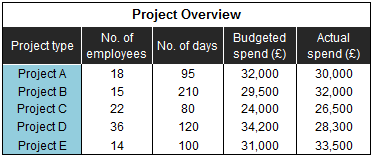Indirect Proportions in Numerical Reasoning
Many people may wonder how to improve at numerical reasoning tests. To score high in numerical reasoning is not a rocket science. Some may argue that it takes years of dedicated study but this may not be necessarily the case. Surely, learning and mastering the skills from the beginning may take some time but you can learn and improve within reasonable time frame. Below we will present tutorial on indirect proportions. You will learn how to work out questions where one quantity decreases and the other increases. If you are preparing for numerical reasoning test and need to review related topics then see ratios and proportions aptitude guide. Good luck with your preparation.
How to work out indirect proportions
Below we will review numerical reasoning questions that assume indirect proportions. Consider the example problem below.
 |
How many more employees have to be on team that will work on project A if the company wants to finish project within 72 days?
The above seemingly tricky question that can come up in numerical reasoning test can be easily worked out. All what is required here is to perform two simple calculations: 95 x 18 / 72 = 23.75 approximately 24, so we now know that if the company wants to finish project within 72 days they need 24 employees. Now, to get the number of employees that need to join the team on project A simply subtract 24 – 18 = 6. Note, that in the above calculation we used indirect proportions which means that one quantity proportionally increases as the other decreases. In the above case, if you need to decrease number of days to finish project you need to add proportional amount of workforce to get the work done. You can also refer to direct proportions in numeracy tests to see the difference between these two concepts.
Now test your understanding and try to work out the below question within 60 seconds.
If the company transferred 18 employees from project A to project B then approximately in how many fewer days would be the project B finished?
For people who do not have extensive experience with indirect proportions the above problem may seem to be tricky to work out. Note that it is possible to work out the above question just in a few moments. Notice, that the problem follows the exact logic as the first question. Hence, if the company transferred 18 employees from project A to project B then project B would have 33 employees. So, to calculate how many days would 33 employees work on project B perform the following calculation: 15 x 210 / 33 = 95.45 approximately 96 days. So if you transferred 18 employees from project A to project B then the work on project B would be done in 114 days earlier, that is 210 – 96 = 114 days.
Note that there are many tricky questions in numerical reasoning tests that may not only be constructed from proportion problems as the examples above but from range of other mathematical functions related to arithmetic or algebraic operations.

